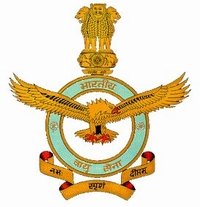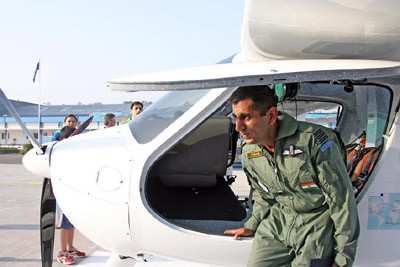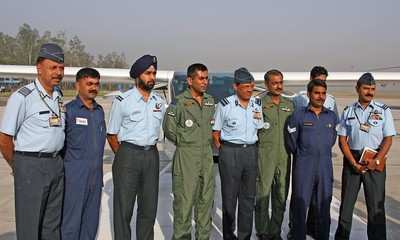Flight Also Celebrates Indian Air Force 75th Anniversary
 Two Indian Air Force
(IAF) fighter pilots are winging a Flight Design CT across the
world, and they've made it to the continental United States.
Two Indian Air Force
(IAF) fighter pilots are winging a Flight Design CT across the
world, and they've made it to the continental United States.
Pilot Rahul Monga, 37, normally flies attack helicopters while
his co-pilot Anil Kumar, 38, handles supersonic jet fighters. Right
now, they are flying the German-manufactured CTSW Advance, hoping
to cover the globe in about 45 days, according to the IAF.
The empty weight of the plane is a little more than 661 pounds
and it has a range of 869 miles with a ceiling of 14,000 feet. It
has a glass cockpit and electronic flight instrumentation system
(EFIS), internal GPS, a satellite tracker and a VOR coupled R/T
set. It is also fitted with an emergency parachute recovery
system.
The two IAF Wing Commanders are scheduled to land near Los
Angeles in the small town of Santa Paula, CA Tuesday morning. They
have taken on this mission not only as an attempt to smash the
current record for circumnavigating the globe in a micro light, but
also as a goodwill mission to celebrate the IAF's 75th
Anniversary.
"I am proud to represent the country and the Indian Air Force in
such an event. Me and my entire team have put in a lot of effort
'planning' the expedition, it's time to live it. With God's grace
and well wishes of the entire country we will be successful," said
Monga just prior to takeoff June 1.
The two have already flown halfway around the world since
leaving Delhi, India. They've battled monsoons up China's eastern
coast, flown over frozen and sparsely-populated areas of Russia and
leaped across the bone-chilling Bering Sea to land in Anchorage,
Alaska.

They crossed the International Date Line on July 4 and gained a
day in their trek, according to the IAF.
"We have got one more day in our expedition to live it fully,"
Monga said.
They are attempting to lop 34 days off the nearly 98-day current
record, but they are running 12 days behind schedule because foul
weather grounded them in a number of countries.
The two pilots say flying -- or, more accurately, landing -- the
CT is just a bit different than their normal fighter jets. Since
the aircraft weighs less than 1100 pounds on takeoff and is highly
susceptible to wind gusts, the plane "lands like a drunken
Dinosaur," according to an IAF release.
At one remote Chinese airstrip they were just about to touch
down when a powerful wind shot them 50 feet back up into the air.
It took three more attempts before they touched down safely.
The most dangerous passage to date was crossing the Bering Sea
on July 5. Monga was the only one flying the craft as it crossed
over the frigid waters because Kumar was replaced on the Russian
leg by a local navigator, a mandatory requirement because that
country's air controllers only speak Russian.
If engine troubles had forced Monga to ditch the plane, he would
have had only six minutes to three hours to survive, depending on
whether he was able to get an immersion survival suit on in
time.
That is where some new tracking and communications technology
onboard the tiny craft provided by a Canadian company would have
come in handy. The Automated Flight Information Reporting System
(AFIRS) was developed by Flyht, a subsidiary of Calgary,
Alberta-based AeroMechanical Services Ltd.
It allows IAF officers sitting in a control room in north
central India to constantly track the micro light's location and
allows them to communicate with the pilot via satellite phone.
Had Monga ditched the aircraft, IAF controllers could have
called in Canadian, American and Russian rescue teams and told them
exactly where in the Bering Sea to look.
The vast majority of current commercial jets don't have radio
contact in large patches of the world; nor can airlines track their
craft in many regions of the globe, the company said.

From Santa Paula, they are scheduled to head northeast to
Colorado Springs, southeast to Jacksonville, FL then due north to
Toronto, Canada. They hope to exit North America from Canada's
frozen north, hop over to Greenland, Iceland, Europe and home to
India.
The journey can be tracked from the IAF website.
 ANN's Daily Aero-Linx (05.06.25)
ANN's Daily Aero-Linx (05.06.25) ANN's Daily Aero-Term (05.06.25): Ultrahigh Frequency (UHF)
ANN's Daily Aero-Term (05.06.25): Ultrahigh Frequency (UHF) ANN FAQ: Q&A 101
ANN FAQ: Q&A 101 Classic Aero-TV: Virtual Reality Painting--PPG Leverages Technology for Training
Classic Aero-TV: Virtual Reality Painting--PPG Leverages Technology for Training Airborne 05.02.25: Joby Crewed Milestone, Diamond Club, Canadian Pilot Insurance
Airborne 05.02.25: Joby Crewed Milestone, Diamond Club, Canadian Pilot Insurance





